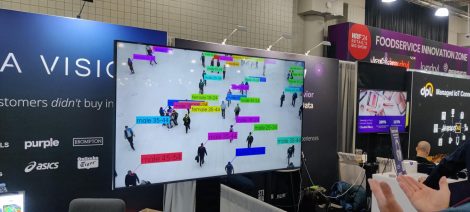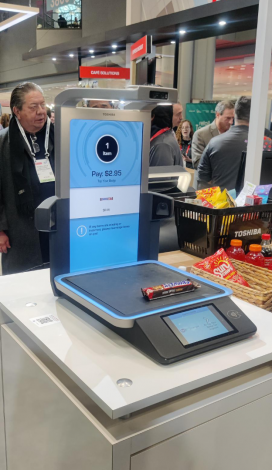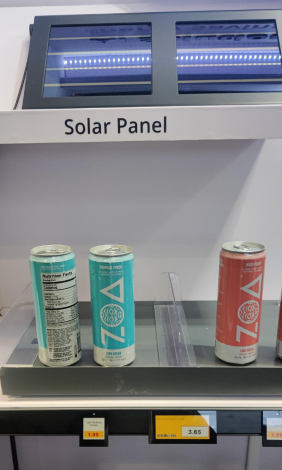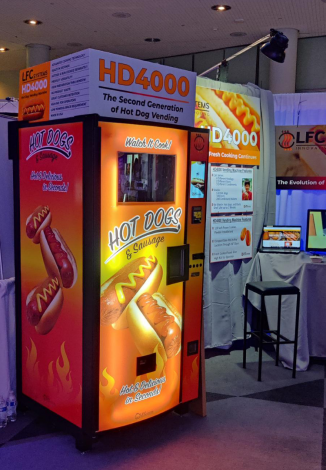The largest annual retail fair NRF 2024 commenced in New York. With more than 40.000 attendees, the event showcases innovations coming to a store near you. In this year’s spotlight – the evolution of AI products, boom of autonomous stores, smart store management solutions and vending 2.0.
‘Brick-and-Mortar Google Analytics’

AI is used to identify shopper gender, age, visit duration, evaluate retail floor hotspots and cold spots
How many visitors viewed the product page? What pages attract the most visitors? Which marketing message got the most buyers interested and led to product purchases?
“These are the most basic metrics in ecommerce. With the help of Computer Vision and AI, the data on visitor age, gender, visit duration, store layout coldspots and hotspots are now available for brick and mortar retailers“, says Sales Director at retail technology company Neto Baltic Kestutis Kadelskas.
By using video security cameras in the store, AI solutions can augment visual data with powerful visitor analytics.
Most importantly, such solutions do not employ face recognition or any biometric identification and are fully GDPR compliant. Yet they provide invaluable information for store layout evaluation, tracking marketing campaigns and planning sales promotions.
End of the Barcode Era?

Next generation SCOs can visually identify the product without the need for barcode scanning
AI object recognition is already commonplace for shelf stock level monitoring or planogram compliance.
“AI can promptly notify a store employee that milk stock levels are getting low in Isle 9, to prevent out of stock scenarios“, says K. Kadelskas.
Yet with significant improvements in Computer Vision technology, we could witness the end of the barcode era.
Barcode history began in 1952 when the invention was patented. It took more than 30 years for barcodes to gain mainstream traction. It is an indistinguishable part of current retail experience. But do we still need them?
Self-checkouts that use visual product recognition – without the need of barcode scanning – were one of the NRF highlights.
“This innovation allows products to be scanned faster, without the need to look for the barcode and point it at the scanner. It can become an interesting alternative for petrol stations and corner stores, where shoppers only buy a few products“, says K. Kadelskas.
Dynamic pricing

ESLs with a solar panel can use store lighting for power
After checking out the product in the physical store, many turn to smartphones to look for a better price online.
Dynamic pricing can help brick and mortar retailers to stay competitive. By using online price scanning engines to monitor competitor pricing and integrating them with electronic shelf labels (ESL), retailers can instantly adapt to dynamic market conditions.
“The competitor pricing data – like sudden product price drops, can be immediately transferred to the store ERP and pushed to ESLs. Without the need to print and replace price labels, these adjustments can be made in an instant. The solution prevents the loss of ‘here and now’ sales, where the shopper is already in your store, yet finds a better deal online“, says K. Kadelskas.
Dynamic pricing helps to adjust prices based on demand, time of day or best before date – automatically lowering the prices for fresh products nearing their expiry date.
ESLs are also getting more efficient. Current battery technology allows up to 10 years of uninterrupted service. ESLs with solar panels – using only the store lighting – were also presented at this year’s show.
The Boom of Autonomous Stores

The number of autonomous store solution vendors is steadily growing – the costs to deploy autonomous stores should decrease
Amazon Go launched seven years ago and everyone thought that autonomous stores are the next big thing in retail. Yet the revolution did not happen. Autonomous stores are still looking for their niche in the retail landscape.
In Europe a Polish retailer Zabka currently operates the largest chain of more than 50 autonomous Zabka Nano stores.
Yet the technological race is well underway. At NRF visitors saw a large number of autonomous store developers from all over the world. Due to the spread of know-how and increasing competition, it is safe to say that the deployment of autonomous stores will become more affordable for retailers.
RFID to Eliminate ‘Ghost Inventory’
‘Listed in the ERP stock, yet nowhere to be found at the store’. The sad truth – inventory tracking at physical stores is wildly inaccurate. Inventory audits are still performed by hand, are time consuming and prone to human errors.
“Typical store stock inventory accuracy is at 80-90%. Imagine that a tenth of your stock is ‘ghost inventory’. This happens due to auditing errors, long intervals between stock audits, theft, reservation and returns”, notes K. Kadelskas.
It is a big pain point for retailers, as ‘ghost inventory’ disrupts the flow of new orders or to track when and where the products went missing.
Inventory discrepancies prevent retailers from employing omnichannel retail scenarios – including ‘buy online, pick up at the store’ or fulfilling orders directly from the store versus a central warehouse.
RFID allows retailers to track products throughout their full journey and increase stock accuracy to 99%. Even inventory audits can happen autonomously, when special robots are deployed at the store. RFID SCOs can also be employed for frictionless and secure checkout.
“The future is omnichannel. Such brands as Nike, Inditex, Adidas or LPP are already using RFID to track their inventory. With decreasing RFID hardware costs and next generation RFID software, RFID solutions will become more commonplace”, says K. Kadelskas.
Hot Meal Vending Machines

Next generation vending machines offer hot meals – like hotdogs or even pizzas
For the NRF dessert – a choice of hot meal vending solutions.
Vending is an old concept. First vending machines appeared at the end of the nineteenth century. At this year’s NRF next generation vending solutions are making a comeback.
An autonomous hotdog vending machine was presented at the NRF. A similar product was presented for making pizza.
“Hot meal vending machines can offer hot food 24/7 and become an attractive proposition for petrol station operators or event organizers – when an all night employee shift does not justify the costs“, says K. Kadelskas.
